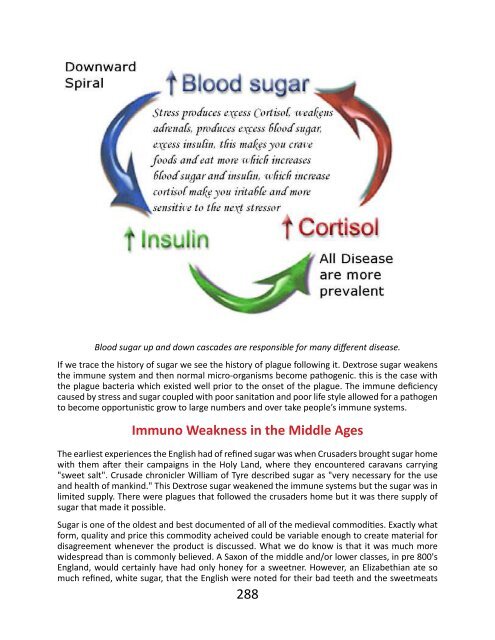You also want an ePaper? Increase the reach of your titles
YUMPU automatically turns print PDFs into web optimized ePapers that Google loves.
Blood sugar up and down cascades are responsible for many different disease.<br />
If we trace the history of sugar we see the history of plague following it. Dextrose sugar weakens<br />
the immune system and then normal micro-organisms become pathogenic. this is the case with<br />
the plague bacteria which existed well prior to the onset of the plague. The immune deficiency<br />
caused by stress and sugar coupled with poor sanitation and poor life style allowed for a pathogen<br />
to become opportunistic grow to large numbers and over take people’s immune systems.<br />
Immuno Weakness in the Middle Ages<br />
The earliest experiences the English had of refined sugar was when Crusaders brought sugar home<br />
with them after their campaigns in the Holy Land, where they encountered caravans carrying<br />
"sweet salt". Crusade chronicler William of Tyre described sugar as "very necessary for the use<br />
and health of mankind." This Dextrose sugar weakened the immune systems but the sugar was in<br />
limited supply. There were plagues that followed the crusaders home but it was there supply of<br />
sugar that made it possible.<br />
Sugar is one of the oldest and best documented of all of the medieval commodities. Exactly what<br />
form, quality and price this commodity acheived could be variable enough to create material for<br />
disagreement whenever the product is discussed. What we do know is that it was much more<br />
widespread than is commonly believed. A Saxon of the middle and/or lower classes, in pre 800's<br />
England, would certainly have had only honey for a sweetner. However, an Elizabethian ate so<br />
much refined, white sugar, that the English were noted for their bad teeth and the sweetmeats<br />
that they consumed. For all the many countries and times between conditions of the sugar varied<br />
considerably. With the following information I hope to establish the cost, quality, and availablity<br />
of sugar. Not only in the British Isles, but on the continent as well.<br />
Sugar In India and Persia<br />
In 510 BC hungry soldiers of the Emperor Darius were near the river Indus, when they discovered<br />
some "reeds which produce honey without bees". They called it shakar By 300 BC the use has<br />
spread and Darius’s army is weakened by over use of the dextrose sugar and Alexander defeats<br />
them outnumbered over ten to one. In 327 BC Alexander the Great army then starts to use the<br />
sugar and gradually they lose strength and dissipate from weakness. Alexander spread dextrose<br />
sugar cane through Persia and introduced it in the Mediterranean. This was the beginning of one<br />
of the best documented products of the Middle Ages. But where ever it goes it first weakens the<br />
immune system.<br />
In 95 AD, in a document entitled "Periplus Maris Erythraei", (or "Guide Book to the Red Sea"), an<br />
unknown merchant says there is "Exported commonly....Honey of reeds which is called sakchar."<br />
This is possibly the first mention in European history of the use of sugar cane as an article of<br />
commerce.<br />
From: "The Wonder That Was India" by A. L. Basham we learn that "In ancient India...."(Since<br />
Nero's Time) "...sugar cane was grown, and exported to Europe..." and "...in the time of the<br />
Caesars...The main requirements of the West were spices, perfumes, jewels and fine textiles, but<br />
lesser luxuries, such as sugar, rice and ghee were also exported."<br />
According to Will Durant, who told us the Darius and Alexander the Great stories above in his "Age<br />
of Faith", pressing and boiling cane to create sugar as such was first done in India about 300 AD.<br />
Prior to this, the juice was used much like honey, as a sweetener for food and drinks. About 540<br />
AD, the Persians had learned sugar making from India. We now know that there was a lot more<br />
contact from India through the Mediterranean world than was previously thought. An example of<br />
this is the manner in which Indian literature found its way to the Western countries.<br />
In "The History and Culture of the Indian People, The Classical Age" Vol. 3, the authors note:<br />
"That Indian literature was highly valued in these countries..." (meaning europe and the med) "....<br />
is known by the history of a single book Panchatantra....translated in the 6th century into pehlevi<br />
then Arabic then from Arabic to Hebrew, Latin, Spanish, Italian and various other languages of<br />
Europe..." (Obviously there was communication and trade...for mention of sugar being traded,<br />
see previous.) They also state in another place that "In the seventh century...sugar canes were<br />
abundant in this country...", meaning India.<br />
By 600 AD, again according to Durant, knowledge of how to produce crystallized sugar was wide<br />
spread in this area. (India and Persia) We do know that in 627 AD, the Greek Emperor Heraclius<br />
seized a treasury of sugar in the Royal Palace at Ctesiphon. In 641 AD, the Arabs without sugar<br />
conquered Persia, and then having learned to cultivate sugar cane, spread it's culture to Egypt,<br />
Sicily, Morrocco, and Spain, from which sources it reached Europe. Disease follows in the wake.<br />
288 289

















